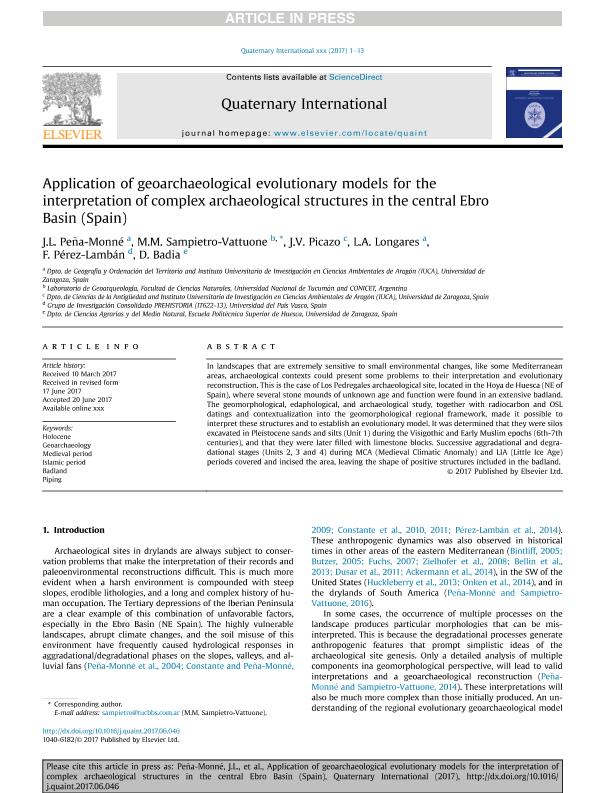Mostrar el registro sencillo del ítem
dc.contributor.author
Peña Monné, José Luis

dc.contributor.author
Sampietro Vattuone, Maria Marta

dc.contributor.author
Picazo Millán, Jesús V.

dc.contributor.author
Longares, Luis Alberto

dc.contributor.author
Pérez Lambán, Fernando

dc.contributor.author
Badia, D.
dc.date.available
2018-12-07T13:32:39Z
dc.date.issued
2018-07
dc.identifier.citation
Peña Monné, José Luis; Sampietro Vattuone, Maria Marta; Picazo Millán, Jesús V.; Longares, Luis Alberto; Pérez Lambán, Fernando; et al.; Application of geoarchaeological evolutionary models for the interpretation of complex archaeological structures in the central Ebro Basin (Spain); Pergamon-Elsevier Science Ltd; Quaternary International; 483; 7-2018; 70-82
dc.identifier.issn
1040-6182
dc.identifier.uri
http://hdl.handle.net/11336/66038
dc.description.abstract
In landscapes that are extremely sensitive to small environmental changes, like some Mediterranean areas, archaeological contexts could present some problems to their interpretation and evolutionary reconstruction. This is the case of Los Pedregales archaeological site, located in the Hoya de Huesca (NE of Spain), where several stone mounds of unknown age and function were found in an extensive badland. The geomorphological, edaphological, and archaeological study, together with radiocarbon and OSL datings and contextualization into the geomorphological regional framework, made it possible to interpret these structures and to establish an evolutionary model. It was determined that they were silos excavated in Pleistocene sands and silts (Unit 1) during the Visigothic and Early Muslim epochs (6th-7th centuries), and that they were later filled with limestone blocks. Successive aggradational and degradational stages (Units 2, 3 and 4) during MCA (Medieval Climatic Anomaly) and LIA (Little Ice Age) periods covered and incised the area, leaving the shape of positive structures included in the badland.
dc.format
application/pdf
dc.language.iso
eng
dc.publisher
Pergamon-Elsevier Science Ltd

dc.rights
info:eu-repo/semantics/openAccess
dc.rights.uri
https://creativecommons.org/licenses/by-nc-sa/2.5/ar/
dc.subject
Badland
dc.subject
Geoarchaeology
dc.subject
Holocene
dc.subject
Islamic Period
dc.subject
Medieval Period
dc.subject
Piping
dc.subject.classification
Meteorología y Ciencias Atmosféricas

dc.subject.classification
Ciencias de la Tierra y relacionadas con el Medio Ambiente

dc.subject.classification
CIENCIAS NATURALES Y EXACTAS

dc.subject.classification
Historia

dc.subject.classification
Historia y Arqueología

dc.subject.classification
HUMANIDADES

dc.title
Application of geoarchaeological evolutionary models for the interpretation of complex archaeological structures in the central Ebro Basin (Spain)
dc.type
info:eu-repo/semantics/article
dc.type
info:ar-repo/semantics/artículo
dc.type
info:eu-repo/semantics/publishedVersion
dc.date.updated
2018-12-05T14:45:33Z
dc.journal.volume
483
dc.journal.pagination
70-82
dc.journal.pais
Estados Unidos

dc.journal.ciudad
Nueva York
dc.description.fil
Fil: Peña Monné, José Luis. Universidad de Zaragoza; España
dc.description.fil
Fil: Sampietro Vattuone, Maria Marta. Consejo Nacional de Investigaciones Científicas y Técnicas. Centro Científico Tecnológico Conicet - Tucumán; Argentina. Universidad Nacional de Tucumán. Facultad de Ciencias Naturales e Instituto Miguel Lillo. Laboratorio de Geoarqueología; Argentina
dc.description.fil
Fil: Picazo Millán, Jesús V.. Universidad de Zaragoza; España
dc.description.fil
Fil: Longares, Luis Alberto. Universidad de Zaragoza; España
dc.description.fil
Fil: Pérez Lambán, Fernando. Universidad del País Vasco; España
dc.description.fil
Fil: Badia, D.. Universidad de Zaragoza; España
dc.journal.title
Quaternary International

dc.relation.alternativeid
info:eu-repo/semantics/altIdentifier/doi/https://dx.doi.org/10.1016/j.quaint.2017.06.046
dc.relation.alternativeid
info:eu-repo/semantics/altIdentifier/url/https://www.sciencedirect.com/science/article/pii/S1040618217303452
Archivos asociados
